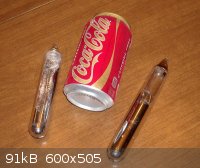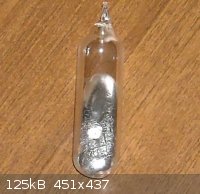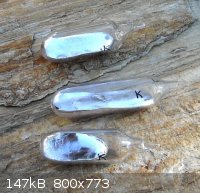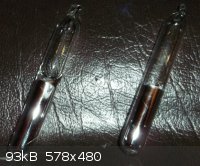Zan Divine
Hazard to Others
  
Posts: 170
Registered: 3-12-2011
Location: New York
Member Is Offline
Mood: Wishing all the worst that life has to offer to that SOB Wayne Lapierre
|
|
Ampoules of shiny K & Na
Many people would like to obtain samples of either sodium or potassium as silvery colored metals in glass ampoules. Often times distillation is the
first thing that comes to mind to prepare pure group 1 metals. This begs the question of how best to distill into an ampoule. While this method can
give absolutely excellent results, it is very complicated to actually carry out.
I recently was asked to prepare glass ampoules containing an ounce of a group 1 metal. The metals in question are sodium and potassium. This method is
absolutely not applicable to lithium, which destroys glass when molten.
If you have rudimentary glassblowing skills and a vacuum pump you can turn out some pretty good samples yourself. The method starts out with a glass
tube. One end is sealed and a constriction is formed setting the length of the product ampoule. By heating the outside of the tube immediately above
the constriction and then pushing a pointed object against it, internal fingers are formed. A wad of stainless steel wool is inserted and held by the
fingers.
The glass tube at this point should look like picture 1.
Now a central globe is blown which serves as the reservoir for the molten metal prior to filtration. The tube is now ready to be charged. Sodium or
potassium pieces which have been freed of all oil are dried on paper towels and the appropriate amount is inserted into the tube. The pieces are
pushed down into the globe area and a new constriction is formed between the globe and the open end of the tube. See picture 2.
A vacuum pump is connected to the open end of the tube, vacuum is applied, and the metal is melted in the globular area. While maintaining the tube
under vacuum, seal off the new constriction. This leaves you with a sealed tube under vacuum. The metal is remelted if it has solidified and the tube
is grasped and swung in such a way that centripetal acceleration causes the metal to be drawn through the metal wool and into the ampoule area. The
constriction about the ampoule is sealed under vacuum. See last picture, K on the left, Na on the right.
  
[Edited on 18-3-2012 by Zan Divine]
|
|
|
AndersHoveland
Hazard to Other Members, due to repeated speculation and posting of untested highly dangerous procedures!
    
Posts: 1986
Registered: 2-3-2011
Member Is Offline
Mood: No Mood
|
|
The reason molten lithium is more corrosive to glass is probably because the formation of Li2O is so favorable, while K2O is not as favorable (crystal
lattice energy). This paper would seem to suggest that Na cannot readily reduce SiO2, while aluminum can: http://dergiler.ankara.edu.tr/dergiler/31/1320/15216.pdf
|
|
|
Dennis SK
Harmless

Posts: 21
Registered: 12-3-2012
Member Is Offline
Mood: No Mood
|
|
Good job!
Its a well known fact that alkali metals are hard for element collectors to find in high shiny quality. The ampoules looks good based on the method
used.
One thing that would be nice to see (and I've never seen that) is NaK sealed in a vial with absolute oxide free surface and free of ampoule "dirt"
Now that is not an easy task, but if succesful... wow!
|
|
|
AndersHoveland
Hazard to Other Members, due to repeated speculation and posting of untested highly dangerous procedures!
    
Posts: 1986
Registered: 2-3-2011
Member Is Offline
Mood: No Mood
|
|
There is also an alloy of K-Na that is liquid at room temperature.
| Quote: |
78% potassium and 22% sodium, is liquid from −12.6 to 785°C, it less dense than water
|
[Edited on 18-3-2012 by AndersHoveland]
|
|
|
blogfast25
International Hazard
    
Posts: 10562
Registered: 3-2-2008
Location: Neverland
Member Is Offline
Mood: No Mood
|
|
Excellent 'How to', Zan. Thanks for sharing. I didn't have the slightest clue how it was done, previous to this.
I guess the caffeine free coke stops you from getting the 'shakes', right? A steady hand definitely needed! 
|
|
|
nora_summers
Harmless

Posts: 34
Registered: 11-11-2010
Member Is Offline
Mood: I am figment of your imagination.
|
|
Beautiful!!!!
that should definetly go in the "pretty pictures" thread! 
|
|
|
m1tanker78
National Hazard
   
Posts: 685
Registered: 5-1-2011
Member Is Offline
Mood: No Mood
|
|
Nice demonstration Zan. I don't understand what the SS wool packing is for. Does it filter the oxides that form during temporary air exposure? Did you
back fill the ampoules with argon?
Without glass blowing skills and equipment, I'm afraid I can't get around having crusty sodium in my collection  I don't trust potassium enough to store even a few months by conventional means. I don't trust potassium enough to store even a few months by conventional means.
Thanks for sharing your method,
Tank
Chemical CURIOSITY KILLED THE CATalyst.
|
|
|
Poppy
Hazard to Others
  
Posts: 294
Registered: 3-11-2011
Member Is Offline
Mood: † chemical zombie
|
|
I see what you did there
Thank you for sharin
Pretty very good job sir!
[Edited on 3-18-2012 by Poppy]
|
|
|
thesourcerer
Harmless

Posts: 6
Registered: 4-3-2012
Member Is Offline
Mood: No Mood
|
|
Struggling to download the photos (now my 4th attempt!) of these antique samples of crystalline Sodium and Potassium in 6" x 3/4" ampoules - for sale!
They are certainly over 50 years old.
 
|
|
|
Zan Divine
Hazard to Others
  
Posts: 170
Registered: 3-12-2011
Location: New York
Member Is Offline
Mood: Wishing all the worst that life has to offer to that SOB Wayne Lapierre
|
|
Quote: Originally posted by m1tanker78  | Nice demonstration Zan. I don't understand what the SS wool packing is for. Does it filter the oxides that form during temporary air exposure? Did you
back fill the ampoules with argon?
Tank |
Yes, that is precisely it. Here's a picture showing what is removed. I don't always blow a globe if the glass is large dia.
I purged with Ar while loading the metal, then it went to vacuum asap (my vacuum quality is better than my inert gas quality). This procedure can be
done without Ar or a vacuum and give good results by an ingeneous trick which I've never actually tried.

[Edited on 19-3-2012 by Zan Divine]
|
|
|
Zan Divine
Hazard to Others
  
Posts: 170
Registered: 3-12-2011
Location: New York
Member Is Offline
Mood: Wishing all the worst that life has to offer to that SOB Wayne Lapierre
|
|
Quote: Originally posted by thesourcerer  | Struggling to download the photos (now my 4th attempt!) of these antique samples of crystalline Sodium and Potassium in 6" x 3/4" ampoules - for sale!
They are certainly over 50 years old.
|
I'll bet you have K on the left...it's exactly what the surface of mine looks like. Distinctly more crystalline than Na...but, then again, it
crystallized more slowly because of the low mp.
|
|
|
Zan Divine
Hazard to Others
  
Posts: 170
Registered: 3-12-2011
Location: New York
Member Is Offline
Mood: Wishing all the worst that life has to offer to that SOB Wayne Lapierre
|
|
Quote: Originally posted by Dennis SK  |
One thing that would be nice to see (and I've never seen that) is NaK sealed in a vial with absolute oxide free surface and free of ampoule "dirt"
Now that is not an easy task, but if succesful... wow! |
The nice thing about the really low-melting active metals is the fact that you can use a syringe to collect samples below the surface and they are
pretty much oxide free.
The trick is the ampoule itself. If I used a brand new, clean pyrex tube and clean it with Alconox, the molten metal seems to find faint residues on
the glass that were invisible. If I clean the tubes with conc. H2SO4 @ 200-300 C for 5 min, this glass has far fewer film formers found on it. It,
however, seems to be much less "slippery" to errant beads of metal which makes a totally clean seal (no darkening of the glass) very hard to achieve.
|
|
|
Dennis SK
Harmless

Posts: 21
Registered: 12-3-2012
Member Is Offline
Mood: No Mood
|
|
Quote: Originally posted by Zan Divine  |
The trick is the ampoule itself. If I used a brand new, clean pyrex tube and clean it with Alconox, the molten metal seems to find faint residues on
the glass that were invisible. If I clean the tubes with conc. H2SO4 @ 200-300 C for 5 min, this glass has far fewer film formers found on it. It,
however, seems to be much less "slippery" to errant beads of metal which makes a totally clean seal (no darkening of the glass) very hard to achieve.
|
You hit the nail there...
Thats excatly why perfectly clean ampoules of alkali metals are so rare.
I've seen/inspected hundreds of ampoules with cesium. Very few ampoules are perfectly clean. I've actually only seen a few.
Until a few weeks ago I had only seen ampoules below 10 grams that where perfectly clean. But then I stumbled upon some 100g ampoules... I found 1
ampoule of 100g that was absolutely clean. Perfectly clean. I had never before seen that in 100g ampoules. That one went straight to my collection.
Often with alkali metals in ampoules, the ampoules can seem perfectly fine. Until you melt the metal... Then it shows that areas of the ampoules the
metal "sticks too" or make tiny tiny dust particles of the metal.
If you ever manage to make very clean ampoules of Na and K, please let me know. I already have some clean ones, but only a couple of grams. Looks a
little akward with a collection like this:
Li: 2g piece under argon in ampoule
Na: 10g melted in ampoule
K: 5g melted in ampoule
Rb: 250g melted in ampoule
Cs: 100g melted in ampoule
So... If you manage to make 100-300g ampules with Na or K, let me know 
Sorry for the off topic talk.
|
|
|
Zan Divine
Hazard to Others
  
Posts: 170
Registered: 3-12-2011
Location: New York
Member Is Offline
Mood: Wishing all the worst that life has to offer to that SOB Wayne Lapierre
|
|
That doesn't sound off-topic at all.
I really appreciate hearing from people who have such a clear appreciation of the facts. You zero'ed in on the most important factor because you've
been there!
I think more than a few people would be surprised at the relative ease of delivering a clean aliquot of molten metal into an ampoule and how often
that same sample doesn't look 100% once you've sealed it, etc.
I'd estimate that I only have a 50 - 60% success rate for cosmetically acceptable (not perfect) samples. UHP Argon would be ideal, but that is not
available in my size of cylinder
I have made only 1 sample that seems perfect. The below Na sample looks like a mirror on the back side and has no extraneous...anything! K is quite
noticeably more difficult

|
|
|
Zan Divine
Hazard to Others
  
Posts: 170
Registered: 3-12-2011
Location: New York
Member Is Offline
Mood: Wishing all the worst that life has to offer to that SOB Wayne Lapierre
|
|
It's the damn mineral oil!
Yup, after all the other reasons why K was a tougher sample to produce were explored and debunked, the simplest of things was the true culprit.
Briefly, the process of preparing the metal for sealing in the purification tube is to peel it like a potato to remove excessive oxide, rinse it in
toluene to remove oil, dry it on paper towels and load it into the tubes. It seemed clean!
Not good enough. Turns out the "larger amount of film formers" in the K ampoules were minute traces of residual oil. When I prepared the K ampoules
from K that I twice remelted under toluene, the quality became comparable to the Na ampoules (made from dry sticks of Na).

Incidentally, K is very easy to substantially upgrade using nothing but a large test tube, a little dry toluene and a heat source. Melt the K under an
inch of toluene and stir gently (don't make it separate into pieces). Most all impurities settle to the bottom...dense brownish sandy looking crap.
The K that solidifies above it can be removed easily and is vastly improved in purity.
[Edited on 5-4-2012 by Zan Divine]
|
|
|
Dennis SK
Harmless

Posts: 21
Registered: 12-3-2012
Member Is Offline
Mood: No Mood
|
|
Those K ampoules looks very good. Good job!
Often its the small things that makes the huge diffrence.
As an element collector I look forward to follow you and see you make better and better samples. Would still love a sample. But it must be much bigger
and perfect. And you will get there if you keep up with those improvements.
Funny that the soviets where so good at ampouling. They made alot of poor quality Rb/Cs but also some very high quality. A quality I believe will
never be seen again. But they didnt produce such ampoules with Na/K .. I wish they would. I badly want such samples in my collection.
I hope you have succes in perfecting your methods and look forward to follow you.
|
|
|
Zan Divine
Hazard to Others
  
Posts: 170
Registered: 3-12-2011
Location: New York
Member Is Offline
Mood: Wishing all the worst that life has to offer to that SOB Wayne Lapierre
|
|
Quote: Originally posted by Dennis SK  | Funny that the soviets where so good at ampouling. They made alot of poor quality Rb/Cs but also some very high quality. A quality I believe will
never be seen again. But they didnt produce such ampoules with Na/K .. I wish they would. I badly want such samples in my collection.
I hope you have succes in perfecting your methods and look forward to follow you. |
Dennis,
You may like these. It's K-Na (55 wt. % K). The one on the left has a little mineral oil. All done with argon purge lines, syringes and mineral oil.

He who makes a beast of himself gets rid of some of the pain of being a man. --HST
|
|
|
elementcollector1
International Hazard
    
Posts: 2684
Registered: 28-12-2011
Location: The Known Universe
Member Is Offline
Mood: Molten
|
|
They look beautiful! Is there any use of a Na/K alloy that Na or K can't do alone? Such as drying, etc?
Elements Collected:52/87
Latest Acquired: Cl
Next in Line: Nd
|
|
|
Zan Divine
Hazard to Others
  
Posts: 170
Registered: 3-12-2011
Location: New York
Member Is Offline
Mood: Wishing all the worst that life has to offer to that SOB Wayne Lapierre
|
|
Thank you. Too bad the picture is crappy. I'll post another as I can but I'm off to West Virginia now.
It serves as a more easily reacted group 1. For example, a reaction I used to do cleaved an organometallic dimer and NaK was used for ease of mixing.
The reactivity is higher than either metal alone. Melted K or Na are not strictly pyrophoric. NaK is.
He who makes a beast of himself gets rid of some of the pain of being a man. --HST
|
|
|
EdMeese
Harmless

Posts: 16
Registered: 25-1-2013
Member Is Offline
Mood: No Mood
|
|
What's the result of Me3SiCl or Me2SiCl2 passivation of the inside of the ampule prior to alkali addition?
|
|
|
elementcollector1
International Hazard
    
Posts: 2684
Registered: 28-12-2011
Location: The Known Universe
Member Is Offline
Mood: Molten
|
|
Also, I've been having trouble sealing my "test tube ampoules". Usually I use glass pipettes, or in the case of larger samples, a small test tube.
However, I never get a true seal on these things - my lithium has since developed a white, milky crust that I can only imagine is lithium hydroxide.
Is there a neat and easy trick to get a good, clean seal?
Elements Collected:52/87
Latest Acquired: Cl
Next in Line: Nd
|
|
|